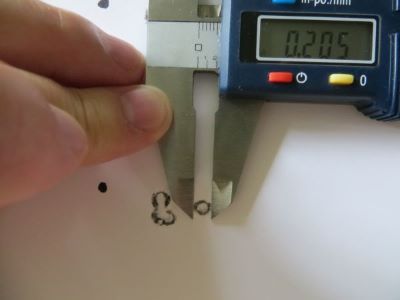This week while shooting I thought I picked up the elusive 0.0XX" group with my .22 at 50 yards. Turns out after properly measuring the group it was a 0.1XX" group, and in conclusion I am still a fair ways off an honest 0.0XX" group.
I used to shoot benchrest competitions (6 PPC) back in the 90's and thought I shot a 0.0XX" group there, but after checking all my targets their were none.
At the benchrest events, the competition scorer would measure all the groups as follows:
1. The person would flatten the target.
2. Measure the group size by taking the largest measurement of the outer most edge of the black ring on both sides of the group.
3. Subtract the bullet diameter and arrive at the overall group size.
So I did a little check and arrived at the following conclusions:
- In order to shoot a 0.0XX" group with a .22 at 50 yards, you would need to have all your 5 shots outer black edges fall with a circle that's outer limits are 0.322 or less.
- Aside from the overall maxmum group size of .0322, in order to get a legitimate 0.0XX group - the group size can be no larger than 0.099" beyond the diameter of a .22 bullet (presumed to be 0.223"). So what does that really look like? See the pic below that shows what a measurement of 0.099" looks like.


Appended are a few of my recent .22 groups and it is deceiving as you look at the small void in the middle and think it is a really small group, until you accurately measure the group.


So in wrap up, I know that likely many people on here have shot legitimate 0.0XX" groups. So can you please post them so we can marvel at them and maybe even have some friendly discussions.
To those who have shot one or more 0.0XX" 5 shot groups - congrats to you as that is an amazing achievement.
I used to shoot benchrest competitions (6 PPC) back in the 90's and thought I shot a 0.0XX" group there, but after checking all my targets their were none.
At the benchrest events, the competition scorer would measure all the groups as follows:
1. The person would flatten the target.
2. Measure the group size by taking the largest measurement of the outer most edge of the black ring on both sides of the group.
3. Subtract the bullet diameter and arrive at the overall group size.
So I did a little check and arrived at the following conclusions:
- In order to shoot a 0.0XX" group with a .22 at 50 yards, you would need to have all your 5 shots outer black edges fall with a circle that's outer limits are 0.322 or less.
- Aside from the overall maxmum group size of .0322, in order to get a legitimate 0.0XX group - the group size can be no larger than 0.099" beyond the diameter of a .22 bullet (presumed to be 0.223"). So what does that really look like? See the pic below that shows what a measurement of 0.099" looks like.
Appended are a few of my recent .22 groups and it is deceiving as you look at the small void in the middle and think it is a really small group, until you accurately measure the group.
So in wrap up, I know that likely many people on here have shot legitimate 0.0XX" groups. So can you please post them so we can marvel at them and maybe even have some friendly discussions.
To those who have shot one or more 0.0XX" 5 shot groups - congrats to you as that is an amazing achievement.
Last edited:











